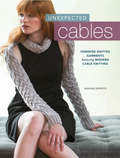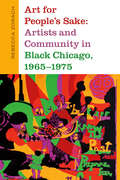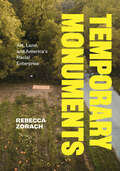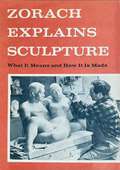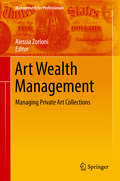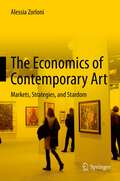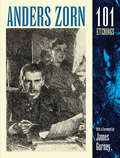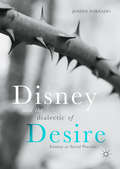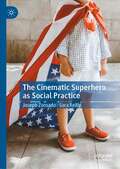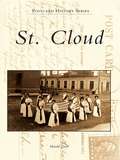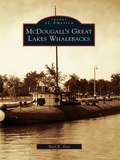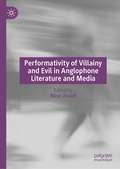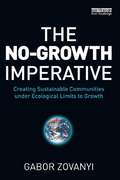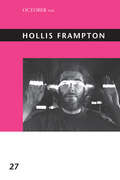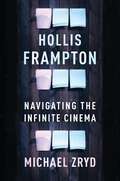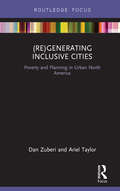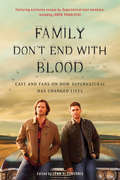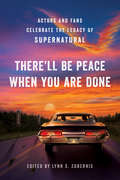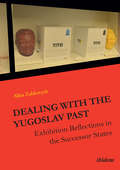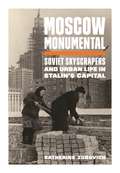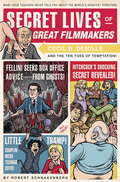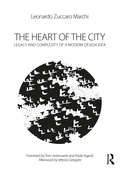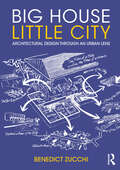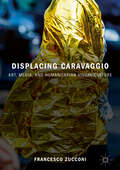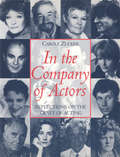- Table View
- List View
Unexpected Cables: Feminine Knitted Garments Featuring Modern Cable Knitting
by Heather ZoppettiTake knitted cables from heirloom to vavoom!In Unexpected Cables author Heather Zoppetti has crafted a fresh, modern, flattering collection of 18 knitted garments. She perfectly captures the essence of the iconic knitted cable and makes cabled designs decidedly fashion-forward!The book features 3 chapters: Refined, Lace, and Abstract.Refined cables explore classic Aran cables using lightweight yarns, twisted stitches, and feminine shapes.In the Lace section, Heather challenges knitters to marry together these two popular knitting techniques with spectacular results.The Abstract section focuses on unusual construction, direction, and texture in cabled projects that have edgy, urban feel. Sleek garment shapes, an interesting mix of cables and lace, and unusual construction converge to bring the generations-old tradition of cable knitting squarely into the here and now. Knitters will delight in making these intriguing, accessible creations!
Art for People's Sake: Artists and Community in Black Chicago, 1965-1975
by Rebecca ZorachIn the 1960s and early 1970s, Chicago witnessed a remarkable flourishing of visual arts associated with the Black Arts Movement. From the painting of murals as a way to reclaim public space and the establishment of independent community art centers to the work of the AFRICOBRA collective and Black filmmakers, artists on Chicago's South and West Sides built a vision of art as service to the people. In Art for People's Sake Rebecca Zorach traces the little-told story of the visual arts of the Black Arts Movement in Chicago, showing how artistic innovations responded to decades of racist urban planning that left Black neighborhoods sites of economic depression, infrastructural decay, and violence. Working with community leaders, children, activists, gang members, and everyday people, artists developed a way of using art to help empower and represent themselves. Showcasing the depth and sophistication of the visual arts in Chicago at this time, Zorach demonstrates the crucial role of aesthetics and artistic practice in the mobilization of Black radical politics during the Black Power era.
Temporary Monuments: Art, Land, and America's Racial Enterprise
by Rebecca ZorachHow art played a central role in the design of America’s racial enterprise—and how contemporary artists resist it. Art has long played a key role in constructing how people understand and imagine America. Starting with contemporary controversies over public monuments in the United States, Rebecca Zorach carefully examines the place of art in the occupation of land and the upholding of White power in the US, arguing that it has been central to the design of America’s racial enterprise. Confronting closely held assumptions of art history, Zorach looks to the intersections of art, nature, race, and place, working through a series of symbolic spaces—the museum, the wild, islands, gardens, home, and walls and borders—to open and extend conversations on the political implications of art and design. Against the backdrop of central moments in American art, from the founding of early museums to the ascendancy of abstract expressionism, Zorach shows how contemporary artists—including Dawoud Bey, Theaster Gates, Maria Gaspar, Kerry James Marshall, Alan Michelson, Dylan Miner, Postcommodity, Cauleen Smith, and Amanda Williams—have mined the relationship between environment and social justice, creating works that investigate and interrupt White supremacist, carceral, and environmentally toxic worlds. The book also draws on poetry, creative nonfiction, hip-hop videos, and Disney films to illuminate crucial topics in art history, from the racial politics of abstraction to the origins of museums and the formation of canons.
Zorach Explains Sculpture: What It Means And How It Is Made
by William ZorachAs noted American sculptor William Zorach explains in this practical and inspirational guide, sculpture is a language, as are music and the spoken word. It is one of the great natural means of human expression. In teaching students to explore this valuable medium, he offers lucid, insightful coverage of such topics as form in art, proportions, anatomy, rhythm, design, and other essentials.Students will also find a wealth of practical guidance for building a figure in clay, casting in plaster and stone, wood carving and wood sculpture, stone carving and sculpture, handling stone, and more. Hundreds of drawings and photographs enhance the text, ranging from ancient Greek terra-cottas to 20th-century masterpieces by Lachaise, Maillol, Brancusi, Epstein, and other masters. There are also many helpful drawings and diagrams illuminating various steps and stages in the sculpting process.Brimming with the distilled artistic wisdom of a lifetime, this enormously informative work belongs not only at the fingertips of every sculptor or sculpture student but in the library of anyone interested in the artistic process and how an artist's vision becomes reality.-Print ed.
Art Wealth Management: Managing Private Art Collections (Management for Professionals #0)
by Alessia ZorloniThis book offers an overview of how to manage private art collections, providing essential insights on art wealth management, art investment, art governance, and succession planning for art assets. It offers practical recommendations on sound art collection governance, but also examines the background of art markets and price building, including the influence of fashion and trends. Throughout history, art patronage has played an important role in the wealth of ultra-high-net-worth families and led to private museums funded by philanthropist collectors in order to celebrate their own tastes and leave a lasting legacy. Today, as a result of the growth of art investing by a new generation of wealthy collectors, not only artists but also wealthy families, sophisticated investors and their close advisors now face a more complex set of financial and managerial needs. As such, the contributions in this book will be of interest to collecting families, family offices, and professional advisors seeking to integrate art into their overall wealth management strategy, and to scholars in the fields of cultural economics, art dealers, curators, and art lovers.
The Economics of Contemporary Art
by Alessia ZorloniThe book examines the contemporary art system with a broad and systematic approach, through the application of models of microeconomics and industrial organizations. By breaking down the traditional barriers between different academic disciplines such as art and economics, this book offers a unique opportunity to grasp the complexities of the contemporary art world and provides the tools to conduct a structural analysis of that market. The result is an in-depth analysis of the contemporary art market from an interdisciplinary perspective. While it is not a textbook in the strictest sense, the book offers a concise and effective overview of all actors in the art system, and provides supporting data and valuable information, both conceptual and practical. It is therefore a text that can be used by students wishing to better understand the complex dynamics that govern the contemporary art market, but also by cultural managers, collectors, potential art investors or simply art lovers who need a quick reference.
101 Etchings (Dover Fine Art, History of Art)
by Anders Zorn James GurneyUninhibited by the limitations of the print medium, Zorn exhibited complete mastery of the plate, bending the art form to suit his own direction. These etchings perfectly showcase his artistic style and technical ability.
Disney and the Dialectic of Desire
by Joseph ZornadoThis book analyzes Walt Disney's impact on entertainment, new media, and consumer culture in terms of a materialist, psychoanalytic approach to fantasy. The study opens with a taxonomy of narrative fantasy along with a discussion of fantasy as a key concept within psychoanalytic discourse. Zornado reads Disney's full-length animated features of the "golden era" as symbolic responses to cultural and personal catastrophe, and presents Disneyland as a monument to Disney fantasy and one man's singular, perverse desire. What follows after is a discussion of the "second golden age" of Disney and the rise of Pixar Animation as neoliberal nostalgia in crisis. The study ends with a reading of George Lucas as latter-day Disney and Star Wars as Disney fantasy. This study should appeal to film and media studies college undergraduates, graduates students and scholars interested in Disney.
The Cinematic Superhero as Social Practice
by Joseph Zornado Sara ReillyThis book analyzes the cinematic superhero as social practice. The study’s critical context brings together psychoanalysis and restorative and reflective nostalgia as a way of understanding the ideological function of superhero fantasy. It explores the origins of cinematic superhero fantasy from antecedents in myth and religion, to twentieth-century comic book, to the cinematic breakthrough with Superman (1978). The authors then focus on Spider-Man as reflective response to Superman’s restorative nostalgia, and read MCU’s overarching narrative from Iron Man to End Game in terms of the concurrent social, political, and environmental conditions as a world in crisis. Zornado and Reilly take up Wonder Woman and Black Panther as self-conscious attempts to reflect on gender and race in restorative superhero fantasy, and explore Christopher Nolan’s Dark Knight trilogy as a meditation on the need for authoritarian fascism. The book concludes with Logan, Wonder Woman 1984, and Amazon Prime’s The Boys as distinctly reflective fantasy narratives critical of the superhero fantasy phenomenon.
St. Cloud (Postcard History Series)
by Harold ZoselSt. Cloud, located on the Mississippi River and in the center of Minnesota, was incorporated on April 2, 1856, by merging three towns together. Through the magic of vintage postcards, travel through time to early in the last century. Readers can see buildings and street scenes that are long gone or changed so much they are unrecognizable today. Explore the granite industry, here since the early 1860s. Meet Samuel Pandolfo, who decided to build an automobile here in 1917. Learn about the man who developed a tin can chair, as well as the St. Cloud Reformatory, which has the largest wall in the United States.
McDougall’s Great Lakes Whalebacks
by Neel R. ZossDuring the last years of the 19th century, the Duluth Harbor, situated between the sister cities of Duluth, Minnesota, and Superior, was the birthplace of a bold and innovative and decidedly odd-looking class of Great Lakes barges and steamships known as whalebacks. Capt. Alexander McDougall and his American Steel Barge Company built the curved-decked, snout-nosed whalebacks on the shores of the harbor, first at Duluth's Rice's Point and later in Howard's Pocket at Superior. The vessels were a radical departure, in design, form, and construction,from the standard shipbuilding concepts of the era but proved themselves more than capable as a number of the boats sailed the Great Lakes and the seaboardsof America until the 1960s. All the whalebacks are gone now--either scrapped or sunk--with one exception. After sailing the lakes for more than 70 years, thelast whaleback, the SS Meteor, returned home to Superior in 1972 and is now continuing its service as a magnificent maritime museum on Barker's Island.
Performativity of Villainy and Evil in Anglophone Literature and Media
by Nizar ZouidiPerformativity of Villainy and Evil in Anglophone Literature and Media studies the performative nature of evil characters, acts and emotions across intersecting genres, disciplines and historical eras. This collection brings together scholars and artists with different institutional standings, cultural backgrounds and (inter)disciplinary interests with the aim of energizing the ongoing discussion of the generic and thematic issues related to the representation of villainy and evil in literature and media. The volume covers medieval literature to contemporary literature and also examines important aspects of evil in literature such as social and political identity, the gothic and systemic evil practices. In addition to literature, the book considers examples of villainy in film, TV and media, revealing that performance, performative control and maneuverability are the common characteristics of villains across the different literary and filmic genres and eras studied in the volume.
The No-Growth Imperative: Creating Sustainable Communities under Ecological Limits to Growth
by Gabor ZovanyiMore than two decades of mounting evidence confirms that the existing scale of the human enterprise has surpassed global ecological limits to growth. Based on such limits, The No-Growth Imperative discounts current efforts to maintain growth through eco-efficiency initiatives and smart-growth programs, and argues that growth is inherently unsustainable and that the true nature of the challenge confronting us now is one of replacing the current growth imperative with a no-growth imperative. Gabor Zovanyi asserts that anything less than stopping growth would merely slow today’s dramatic degradation and destruction of ecosystems and their critical life-support services. Zovanyi makes the case that local communities must take action to stop their unsustainable demographic, economic, and urban increases, as an essential prerequisite to the realization of sustainable states. The book presents rationales and legally defensible strategies for stopping growth in local jurisdictions, and portrays the viability of no-growth communities by outlining their likely economic, social, political, and physical features. It will serve as a resource for those interested in shifting the focus of planning from growth accommodation to the creation of stable, sustainable communities. While conceding the challenges associated with transforming communities into no-growth entities, Zovanyi concludes by presenting evidence that suggests that prospects for realizing states of no growth are greater than might be assumed.
Hollis Frampton (October Files #26)
by Michael ZrydThe first collection of critical writing on the work of experimental filmmaker Hollis Frampton.Hollis Frampton (1936–1984) was one of the most important experimental filmmakers and theorists of his time, and in his navigation of artistic media and discourses, he anticipated the multimedia boundary blurring of today&’s visual culture. Indeed, his photography continues to be exhibited, and a digital edition of his films was issued by the Criterion Collection. This book offers the first collection of critical writings on Frampton&’s work. It complements On the Camera Arts and Consecutive Matter, published in the MIT Press&’s Writing Art series, which collected Frampton&’s own writings. October was as central to Frampton as he was to it. He was both a frequent contributor—appearing in the first issue in 1976—and a frequent subject of contributions by others. Some of these important and incisive writings on Frampton&’s work are reprinted here. The essays collected in this volume consider Frampton&’s photographic practice, which continued even after he turned to film; survey his film work from the 1960s to the late 1970s; and explore Frampton&’s grounding in poetics and language. Two essays by the late Annette Michelson, one of the twentieth century&’s most influential writers on experimental film, place Frampton in relation to film and art history. ContributorsGeorge Derk, Ken Eisenstein, Hollis Frampton, Peter Gidal, Barry Goldensohn, Brian Henderson, Bruce Jenkins, Annette Michelson, Christopher Phillips, Melissa Ragona, Allen S. Weiss, Federico Windhausen, Lisa Zaher, Michael Zryd
Hollis Frampton: Navigating the Infinite Cinema (Film and Culture Series)
by Michael ZrydHollis Frampton was an American filmmaker, photographer, and theorist who bridged the experimental film and contemporary art worlds in the 1960s and 1970s. Best known for avant-garde films including Zorns Lemma (1970) and (nostalgia) (1971), Frampton spent his later years working on the unfinished epic Magellan, a monumental cycle that used the metaphor of Ferdinand Magellan’s circumnavigation of the world to rethink the natures and meanings of history, modernity, and cinema. Frampton’s career was cut short by cancer at age 48, with his vast ambitions for the project left incomplete.This book is a groundbreaking and comprehensive account of this remarkable figure’s work in its totality, from Frampton’s earliest films through Magellan. Michael Zryd explores the connections linking Frampton’s art and thought to other media forms, histories, and cultural frameworks. He foregrounds Frampton’s notion of the “infinite cinema,” which redefined the parameters of the medium to encompass all forms of moving image and sound media across the past and future of cinematic possibility. Zryd analyzes Frampton’s ambivalent relationship with modernism and the Enlightenment, showing how the artist navigated between attraction to radical artistic investigation and awareness of this tradition’s implication in colonialism and other oppressive power structures. Shedding new light on Frampton’s project of exploring and critiquing how cinema attempts to capture and understand the world, this book also considers his significance for contemporary art.
(Re)Generating Inclusive Cities: Poverty and Planning in Urban North America
by Dan Zuberi Ariel Judith TaylorAs suburban expansion declines, cities have become essential economic, cultural and social hubs of global connectivity. This book is about urban revitalization across North America, in cities including San Francisco, Toronto, Boston, Vancouver, New York and Seattle. Infrastructure projects including the High Line and Big Dig are explored alongside urban neighborhood creation and regeneration projects such as Hunters Point in San Francisco and Regent Park in Toronto. Today, these urban regeneration projects have evolved in the context of unprecedented neoliberal public policy and soaring real estate prices. Consequently, they make a complex contribution to urban inequality and poverty trends in many of these cities, including the suburbanization of immigrant settlement and rising inequality. (Re)Generating Inclusive Cities wrestles with challenging but important questions of urban planning, including who benefits and who loses with these urban regeneration schemes, and what policy tools can be used to mitigate harm? We propose a new way forward for understanding and promoting better urban design practices in order to build more socially just and inclusive cities and to ultimately improve the quality of urban life for all.
Family Don't End with Blood: Cast and Fans on How Supernatural Has Changed Lives
by Lynn S. ZubernisHow a Show, and the Support of Its Fandom, Changed—and Saved—Lives Supernatural, a three-time People's Choice Award winner for Favorite Sci-Fi/Fantasy TV Show and Tumblr's 2015 Most Reblogged "Live Action TV," has made a name for itself by supporting and encouraging its fans to "always keep fighting," and a memorable line from early in the show's run, "Family don't end with blood," became an inspiring mantra for many who found community in the fandom. In 25 powerful chapters written by Supernatural's actors and fans, including series lead Jared Padalecki, plus special messages from Jensen Ackles, Misha Collins, and Mark Sheppard, Family Don't End with Blood: Cast and Fans On How Supernatural Has Changed Lives examines the far reach of the show's impact for more than a decade. Supernatural has inspired fans to change their lives, from getting "sober for Sam" to escaping a cult to pursuing life-long dreams. But fans aren't the only ones who have been changed. The actors who bring the show to life have also found, in the show and its community, inspiration, courage, and the strength to keep going when life seemed too hard. Including essays and special messages from Supernatural 's cast: • Jared Padelecki ("Sam Winchester") • Jensen Ackles ("Dean Winchester") • Misha Collins ("Castiel") • Mark Sheppard ("Crowley") • Jim Beaver ("Bobby Singer") • Ruth Connell ("Rowena MacLeod") • Osric Chau ("Kevin Tran") • Rob Benedict ("Chuck Shurley aka God") • Kim Rhodes ("Sheriff Jody Mills") • Briana Buckmaster ("Sheriff Donna Hanscum") • Matt Cohen ("Young John Winchester") • Gil McKinney ("Henry Winchester") • Rachel Miner ("Meg Masters") Collected and edited by Lynn S. Zubernis, a clinical psychologist, professor, and passionate Supernatural fangirl, Family Don't End with Blood provides an insightful and often uplifting look into the way international fan communities become powerful, positive forces in the lives of so many. In keeping with the show's message to "always keep fighting," a portion of the proceeds from the book will be donated to RANDOM ACTS, a nonprofit founded by Misha Collins, and AT TITUDES IN REVERSE, whose mission is to educate young people about mental health and suicide prevention.
There'll Be Peace When You Are Done: Actors and Fans Celebrate the Legacy of Supernatural
by Lynn S. ZubernisFifteen years. Two brothers. Angels and demons. A story like no other. And one of the most passionate fan bases of all time. That's Supernatural. There'll Be Peace When You Are Done: Actors and Fans Celebrate the Legacy of Supernatural is an emotional look back at the beloved television show Supernatural as it wraps up its final season after fifteen unprecedented years on air. With heartfelt chapters written by both the series' actors and its fans—plus full-color photos and fan illustrations—There'll Be Peace When You Are Done traces Supernatural's evolution, the memorable characters created by its writers and brought to life by its talented actors, and the many ways in which the show has inspired and changed the lives of both its viewers and cast. Both a celebration of Supernatural and a way of remembering what made it so special, this book is a permanent reminder of the legacy the show leaves behind and a reminder to the SPN Family to, like the series' unofficial theme song says, "carry on." Featuring chapters from Jared Padalecki ("Sam Winchester") and Jensen Ackles ("Dean Winchester"), which include some of the most heartfelt and emotional things they've previously said about Supernatural that they want fans to remember—plus new reflections about Sam and Dean's legacy, There'll Be Peace When You Are Done also includes original contributions from: • Richard Speight, Jr. ("Gabriel") • Chad Lindberg ("Ash") • Julie McNiven ("Anna Milton") • Tahmoh Penikett ("Gadreel") • Shoshannah Stern ("Eileen Leahy") • Rick Worthy ("Alpha Vamp") • David Haydn-Jones ("Arthur Ketch") • Lauren Tom ("Linda Tran") • And many more, including a special message from Misha Collins ("Castiel") Edited by Lynn S. Zubernis, a clinical psychologist, professor, and passionate Supernatural fangirl, There'll Be Peace When You Are Done is the ultimate send-off for this iconic show that has touched and changed the lives of so many fans across all walks of life.
Dealing with the Yugoslav Past: Exhibition Reflections in the Successor States
by Alina ZubkovychThis book analyzes the representation of the socialist past in the national history museums of the former Yugoslavia. Through travels to Croatia, Bosnia and Herzegovina, Montenegro, Kosovo, and Macedonia, the study elucidates the process of constructing the national narratives that maintain and legitimize a particular vision of the common past. Cross-national comparison allows for analysis of the democratic development of each state in relation to the politics of memory in the region and the role of political actors in its construction.
Moscow Monumental: Soviet Skyscrapers and Urban Life in Stalin's Capital
by Katherine ZubovichAn in-depth history of the Stalinist skyscraperIn the early years of the Cold War, the skyline of Moscow was forever transformed by a citywide skyscraper building project. As the steel girders of the monumental towers went up, the centuries-old metropolis was reinvented to embody the greatness of Stalinist society. Moscow Monumental explores how the quintessential architectural works of the late Stalin era fundamentally reshaped daily life in the Soviet capital.Drawing on a wealth of original archival research, Katherine Zubovich examines the decisions and actions of Soviet elites—from top leaders to master architects—and describes the experiences of ordinary Muscovites who found their lives uprooted by the ambitious skyscraper project. She shows how the Stalin-era quest for monumentalism was rooted in the Soviet Union's engagement with Western trends in architecture and planning, and how the skyscrapers required the creation of a vast and complex infrastructure. As laborers flooded into the city, authorities evicted and rehoused tens of thousands of city residents living on the plots selected for development. When completed in the mid-1950s, these seven ornate neoclassical buildings served as elite apartment complexes, luxury hotels, and ministry and university headquarters.Moscow Monumental tells a story that is both local and broadly transnational, taking readers from the streets of interwar Moscow and New York to the marble-clad halls of the bombastic postwar structures that continue to define the Russian capital today.
Secret Lives of Great Filmmakers
by Mario Zucca Robert SchnakenbergStrange-But-True Tales of Cross-Dressers, Drug Addicts, Foot Fetishists, and Other Legendary Filmmakers. With outrageous and uncensored profiles of everyone from D. W. Griffith to Quentin Tarantino, Secret Lives of Great Filmmakers reveals the little-known secrets of all your favorite directors. Why did Charlie Chaplin refuse to bathe for weeks at a time? Was Alfred Hitchcock really missing a belly button? Is Walt Disney's corpse preserved in a state of suspended animation? And why on earth did Francis Ford Coppola direct a 3-D pornographic movie? The legends of the silver screen will never be the same!
The Heart of the City: Legacy and Complexity of a Modern Design Idea
by Leonardo Zuccaro MarchiThe Heart of the City concept, which was introduced at CIAM 8 in 1951, has played an important role in architectural and urban debates. The Heart became the most important of the organic references used in the 1950s for defining a theory of urban form. This book focuses on both the historical and theoretical reinterpretation of this seminal concept. Divided into two main sections, both looking at differing ways in which the Heart has influenced more recent urban thinking, it illustrates the continuity and the complexities of the Heart of the City. In doing so, this book offers a new perspective on the significance of public space and shows how The Heart of the City still resonates closely with contemporary debates about centrality, identity and the design of public space. It would be of interest to architects, academics and students of urban design and planning.
Big House Little City: Architectural Design Through an Urban Lens
by Benedict ZucchiCombining architectural and urban thinking in an unusual and engaging way, this book presents an integrated approach to architectural theory and design. Leon Battista Alberti’s assertion in his famous Renaissance treatise that ‘the city is like a big house, and the house is in turn like a little city’ forms the springboard for a series of reflections on architecture’s relationship with urbanism and how their once intimate symbiosis, unravelled by International Style Modernism, can be recovered. Explicit references to Alberti’s house-city phrase have been made by figures as diverse as the architects Louis Kahn, Aldo Van Eyck, Denys Lasdun and Niels Torp and novelist Italo Calvino. But, as the book shows, thinking of buildings as little cities provides a new lens through which to reappraise the contributions of many other architects, including Le Corbusier, Frank Lloyd Wright, Alvar Aalto, Eliel Saarinen, Bernard Rudofsky, Hans Scharoun, Leon Krier, Fumihiko Maki, Charles Correa and Team 10. In doing so, the author identifies common themes that form an unexpected bridgehead between the urban and architectural approaches of Antiquity, the Middle Ages, Renaissance and 20th century. The book explores buildings from across the globe, including lesser-known projects, such as Wright’s unbuilt house in Italy or Saarinen’s master plan for Cranbrook Academy, as well as more recent projects by Niels Torp, Behnisch Architekten, Sou Fujimoto, Peter Barber and WOHA. It concludes with practical case studies of residential, health, education and workplace projects from different countries, fulsomely illustrated with many drawings and photographs. These show how architectural design viewed through an urban lens provides a conceptual framework for breaking down the scale of large buildings and integrating them with their context. And crucially, these also show a very accessible way of explaining evolving designs to the intended users and eliciting their participation in the design process. The book offers a compelling approach to the design of projects at all scales, within an ecological perspective: the sense that big and small, cities and buildings must be approached holistically if we are to reverse the degradation and depletion of our habitat, both natural and man-made.
Displacing Caravaggio: Art, Media, and Humanitarian Visual Culture
by Francesco Zucconi Zakiya HanafiThis book takes its start from a series of attempts to use Caravaggio’s works for contemporary humanitarian communications. How did his Sleeping Cupid (1608) end up on the island of Lampedusa, at the heart of the Mediterranean migrant crisis? And why was his painting The Seven Works of Mercy (1607) requested for display at a number of humanitarian public events? After critical reflection on these significant transfers of Caravaggio’s work, Francesco Zucconi takes Baroque art as a point of departure to guide readers through some of the most haunting and compelling images of our time. Each chapter analyzes a different form of media and explores a problem that ties together art history and humanitarian communications: from Caravaggio’s attempt to represent life itself as a subject of painting to the way bodies and emotions are presented in NGO campaigns. What emerges from this probing inquiry at the intersection of art theory, media studies and political philosophy is an original critical path in humanitarian visual culture.
In the Company of Actors: Reflections on the Craft of Acting (Stage And Costume Ser.)
by Carole ZuckerIn the Company of Actors is a wonderful ensemble of entertaining and illuminating discussions with sixteen of the most celebrated and prestigious actors in contemporary theatre, film and television. The impressive list of actors includes: Eileen Atkins, Alan Bates, Simon Callow, Judi Dench, Brenda Fricker, Nigel Hawthorne, Jane Lapotaire, Janet McTeer, Ian Richardson, Miranda Richardson, Stephen Rea, Fiona Shaw, Anthony Sher, Janet Suzman, David Suchet, and Penelope Wilton. Carole Zucker covers a wide range of topics including the actors' main childhood influences, their actor training, early acting experience, preparation for roles and sound advice for coping with actors' problems such as creative differences with other actors or directors.
